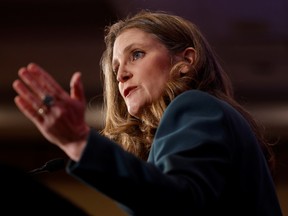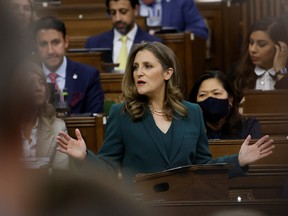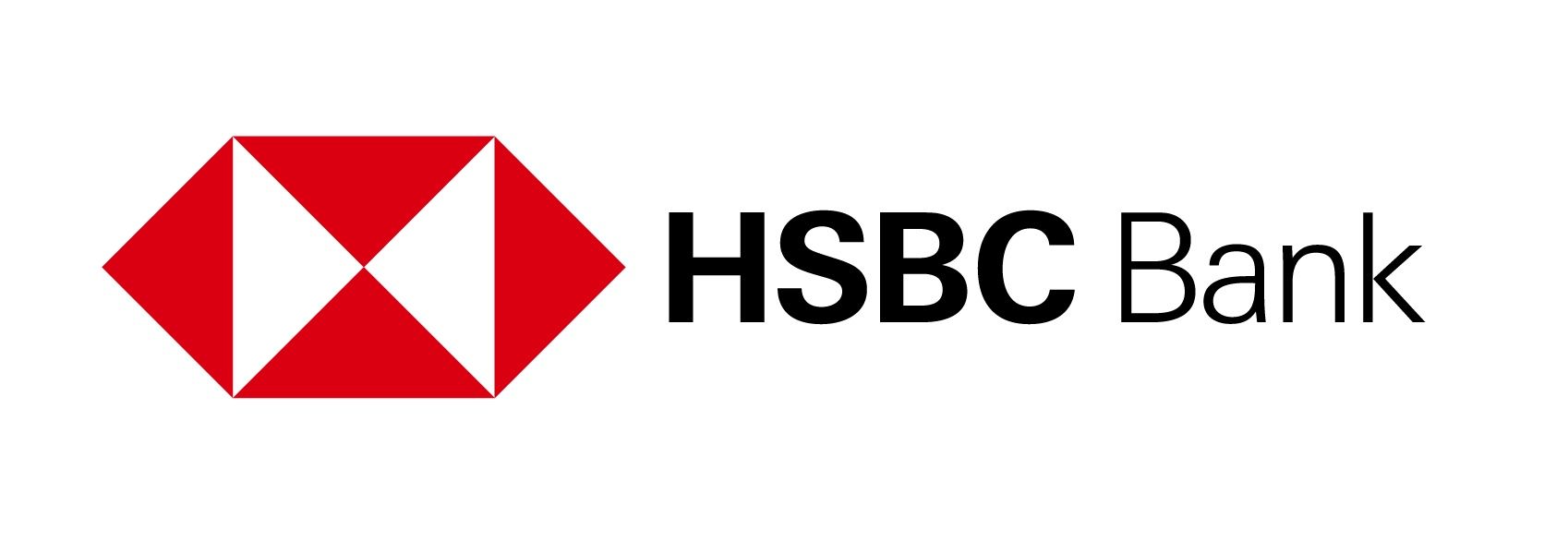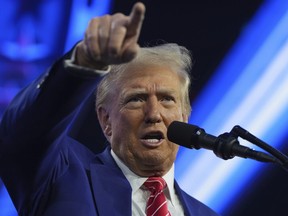With Finance forecasting a downside economic scenario survivable, Freeland made a choice to go all-in. Now Canada must deliver

Article content
The Finance Department might want to stop relying on Bay Street for its economic forecasts and go with its in-house scenario planning — especially if the bureaucrats can convince the minster to adhere to their worst-case scenarios.
Advertisement 2
Article content
In the 1990s, Finance Minister Paul Martin stopped publishing his department’s forecasts because after a generation of big deficits, no one trusted them. To bolster confidence in his budgets and keep the bond vigilantes at bay, Martin adopted the consensus outlook of Canada’s big financial institutions as the government’s official stance. It worked, and the convention stuck.
Article content
Article content
Lately, Finance economists have been sticking their heads out from behind the curtain. The department now pairs the private consensus with “downside” and “upside” scenarios in budgets and economic updates. Those scenarios might be a better way to get a sense of where things are headed.
A year ago, in the immediate aftermath of Russia’s invasion of Ukraine, budget 2022 included a “heightened impact scenario” and a “moderate impact scenario.” (One imagines it would have been uncouth to consider “upside” surprises amid a war in Europe.) The bad outcome would have resulted in economic growth of 0.4 per cent in 2023, compared with the “official” forecast of 3.1 per cent. (The “moderate impact” scenario produced growth of four per cent.)
Advertisement 3
Article content
Jump to budget 2023, tabled by Finance Minister Chrystia Freeland on March 28. The growth assumption on which the budget is based: 0.3 per cent. The doomsters at Finance saw something the rest of us didn’t.
The assumptions behind the downside scenario in 2022 weren’t perfect. Finance economists told their model that the West Texas Intermediate oil price would peak at US$180 in the second quarter of 2022; it crested at around US$120 in June. But directionally, the scenario was closer to what happened in reality. The variable that “in response to higher inflation, global interest rates rise higher and more quickly than anticipated,” proved to be uncanny in its plausibility.

Bay Street economists reacted negatively to Freeland’s latest budget. Her November fiscal update showed a path to a surplus, but she now projects a deficit of $14 billion in the fiscal year that ends March 31, 2028. That’s only 0.4 per cent of gross domestic product, a number that most of Canada’s peers would happily take. But as should be viscerally apparent to everyone by now, a lot can happen in five years. One thing that could happen is the world’s bond investors grow wary of buying and holding the debt of profligate sovereigns and demand higher interest rates. Something else that could happen is a new crisis that forces Ottawa to come up with another expensive rescue package.
Article content
Advertisement 4
Article content
Given the world is in a fragile state amid war in Europe, potential for war in Asia and a financial system weakened by a long period of complacency about risks such as inflation, a prudent government would have made anti-fragility its priority. Prime Minister Justin Trudeau’s government didn’t do that, signalling that it’s in no hurry to pay off its COVID-19-era debt.
In fact, the debt as a percentage of the size of gross domestic product is now projected to rise, meaning Trudeau’s fiscal anchor — a pledge to keep the debt-to-GDP ratio on a downward slope — has become dislodged. A government with a reputation for profligacy will be asking the people who buy its debt simply to trust that Canada remains a safe credit risk. There’s no longer any evidence that the prime minister and the finance minister truly mean it.
Advertisement 5
Article content

“With spending failing to right-size following the pandemic — program spending as a share of GDP is still significantly higher than before the pandemic — the government has left itself in a difficult position as it heads into an economic slowdown,” Royal Bank of Canada economists Cynthia Leach and Josh Nye said in a note. “With the federal government taking on a larger role in funding health care and promoting the energy transition, progress on reducing deficit and debt-to-GDP will be sluggish at best.”
Alas, an anti-fragile budget was probably never on the table. The forces working against one were too great.
The government didn’t leave itself in a difficult position with this budget, as the Royal economists observed. That happened before, when Trudeau followed an early election call with a weak campaign, a disastrous combination (for Liberals) that ultimately led to a power sharing deal with the New Democratic Party. Freeland budgeted an additional $30 billion for health care and affordable dental care, the price NDP leader Jagmeet Singh demanded for his support.
Advertisement 6
Article content

That’s not the difference between deficit and surplus, but it’s a big part of the change from the end of last year. Was it folly? Maybe. But if it was, it was folly backed by parties that collected roughly 64 per cent of the popular vote in the 2021 election. There isn’t an executive on Bay Street who wouldn’t have done the same thing if confronted with a similar existential threat to the franchise she or he had been entrusted to manage.
And then there was the U.S. Inflation Reduction Act, that cornucopia of climate incentives that all but assured Canada would take a back seat to the green industrial revolution if Ottawa did nothing to match it.
Freeland would have heard from free-market purists saying subsidies are wasteful and that bureaucrats can’t pick winners. She also would have heard from industrialists such as Ken Seitz, the chief executive of Nutrien Inc., who is gearing up to build a clean ammonia plant in Louisiana with newfound “confidence” in the project thanks to IRA subsidies. “The region that is attracting the investment may be attracting the forms of innovation, that swath of skills, that you invite with some of those technologies,” Seitz said in an interview during a visit to Ottawa earlier this month.
Advertisement 7
Article content
Who would you side with if you were Freeland, the free-market economists or the executives who will decide how capital is deployed? It’s no contest, especially when the forecasters in your department predict a plausible downside scenario based on current circumstances — one that includes another quarter-point interest rate increase by the Bank of Canada, persistent banking turmoil and a sharper housing downturn — would be survivable.
Finance’s hypothetical downbeat outlook is for a 0.2 per cent decline in GDP this year, followed by a weak recovery of one per cent in 2024. The deficit would widen by an average of $7.2 billion annually over the five-year projection because of lower revenue and higher borrowing costs. The debt-to-GDP ratio would jump to 44.4 per cent, and then slide back to 41.5 per cent, which is roughly where it sits now.
Advertisement 8
Article content
-

Unexpected dividend tax change fresh hit to insurers, banks
-

Timelines key as budget promises billions for green transition
-

Grocery rebates, junking junk fees: What’s in budget for Canadians
Ultimately, Freeland’s options were anti-fragile or all-in. The latter choice meant avoiding defeat in the Commons and setting the foundation for a potentially huge industrial boom — with the risk being that things are no worse in five years than they are now. It was a reasonable bet. Now, all the government has to do is deliver because it’s used up all its room to maneuver.
• Email: kcarmichael@postmedia.com | Twitter: carmichaelkevin
Federal budget 2023: Why Chrystia Freeland turned on the spending taps
2023-03-29 14:50:59







Comments
Postmedia is committed to maintaining a lively but civil forum for discussion and encourage all readers to share their views on our articles. Comments may take up to an hour for moderation before appearing on the site. We ask you to keep your comments relevant and respectful. We have enabled email notifications—you will now receive an email if you receive a reply to your comment, there is an update to a comment thread you follow or if a user you follow comments. Visit our Community Guidelines for more information and details on how to adjust your email settings.
Join the Conversation